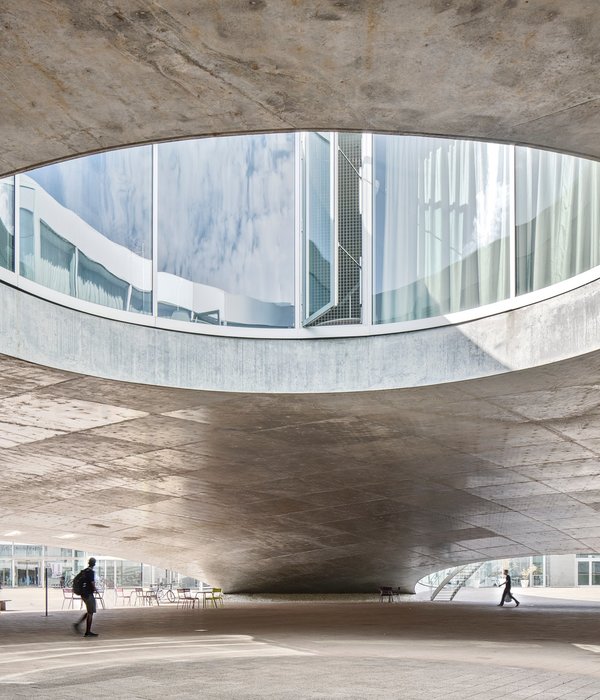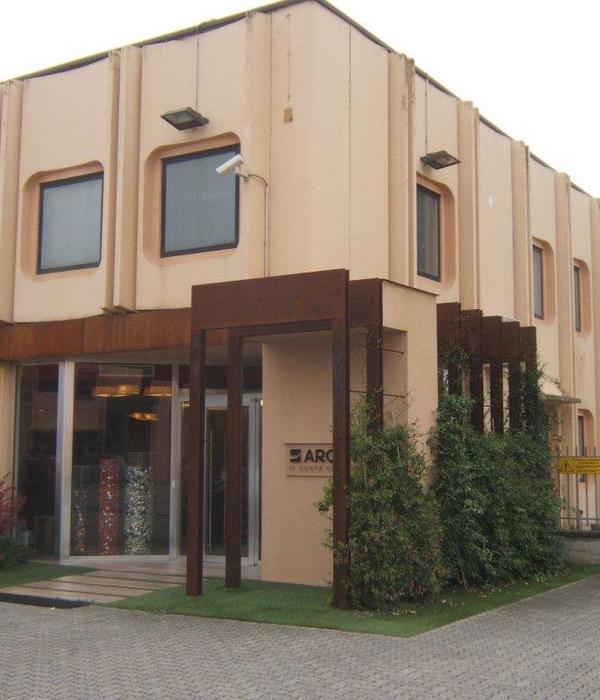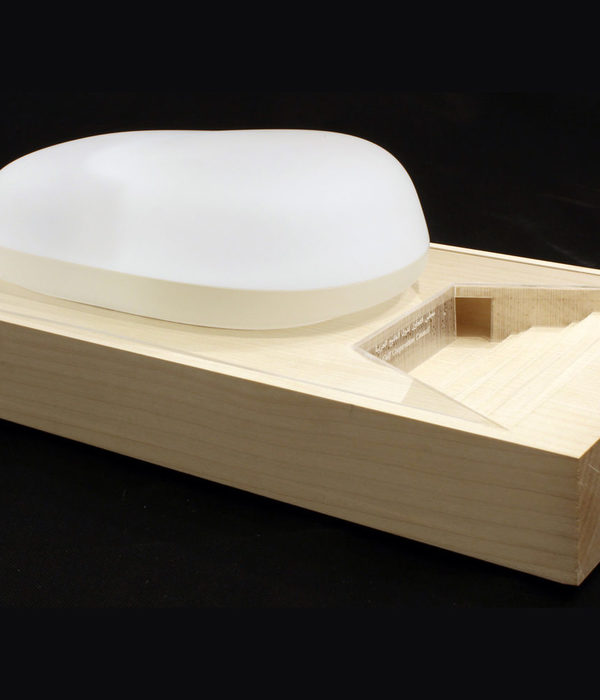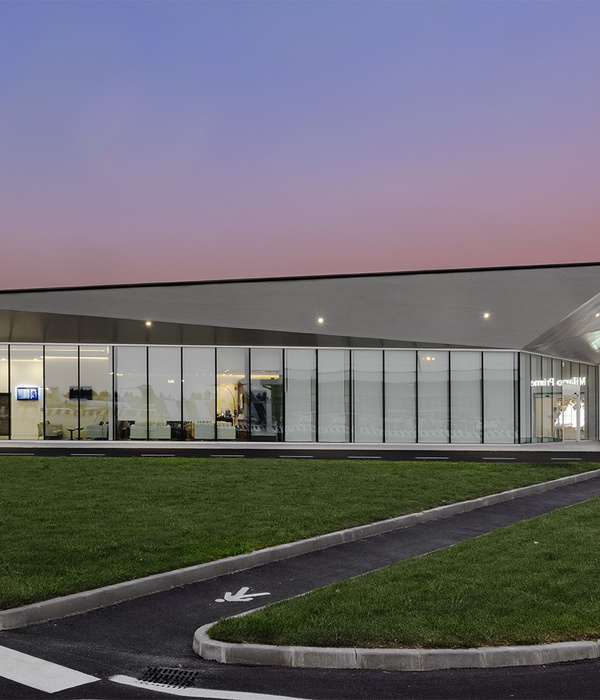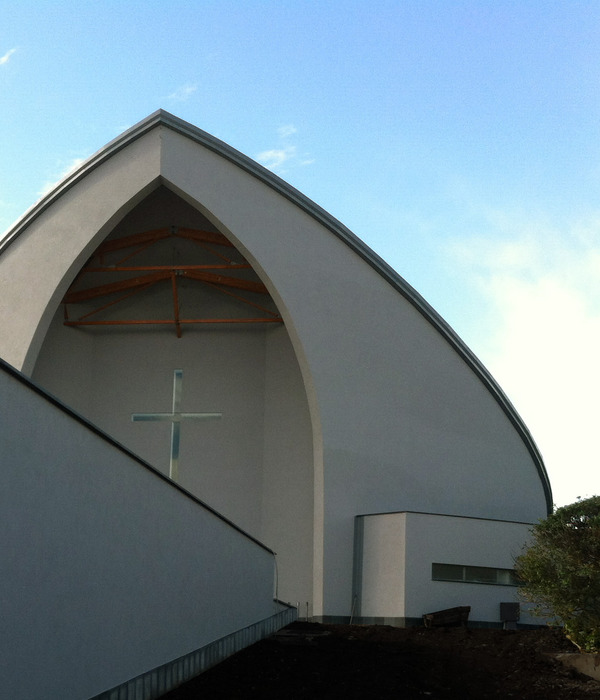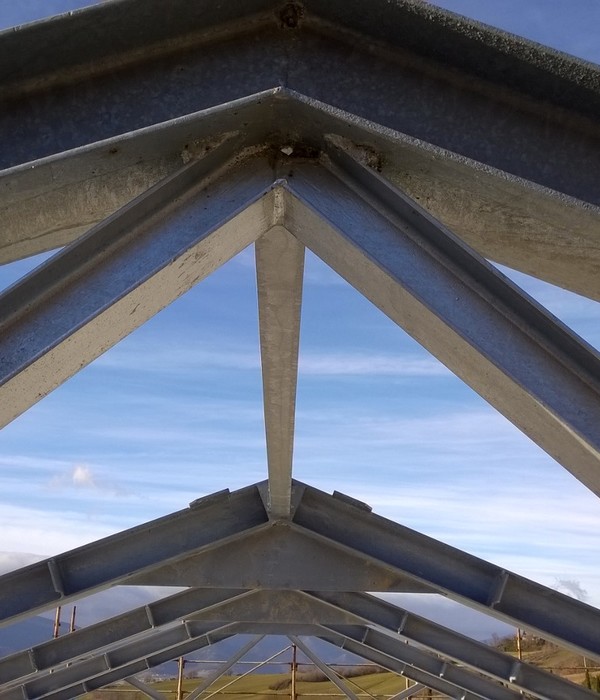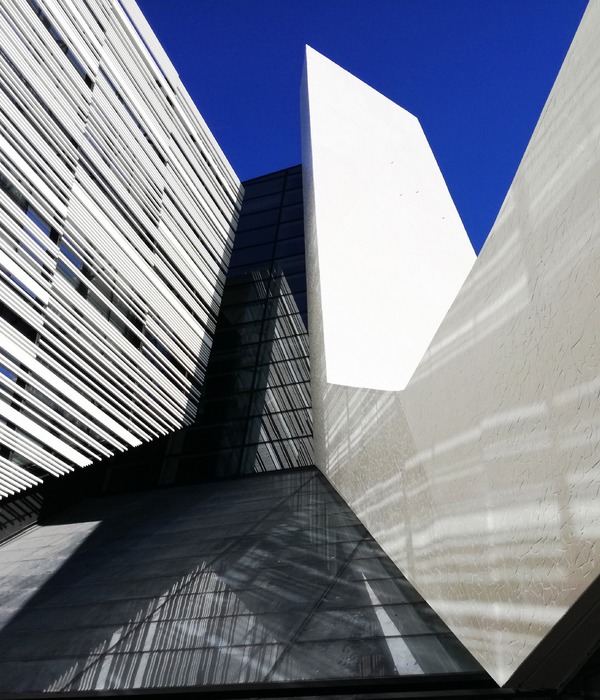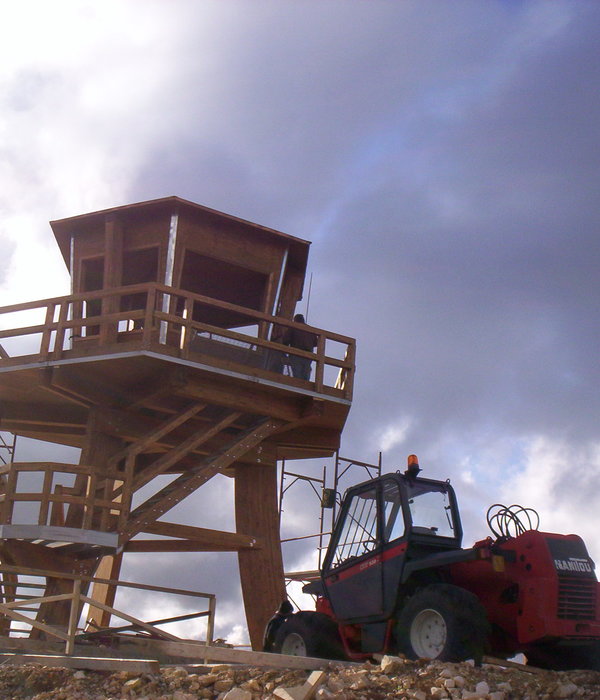- 项目名称:南京长江大桥桥头堡空间改造设计
- 项目地点:南京长江大桥南堡公园
- 设计面积:1500平方米
- 主持建筑师:鲁安东
- 室内设计:LanD Studio,南京大学建筑规划设计研究院
- 照明设计:张昕,清华大学建筑学院张昕工作室
- 机电设计:南京大学建筑规划设计研究院
- 项目管理:南京大学建筑规划设计研究院
- 施工单位:南通华宇建筑装饰有限公司
- 设计周期:2016年06月-2018年10月
- 施工周期:2018年06月-2019年01月
- 建筑摄影:侯博文,南京都市建筑摄影
南京长江大桥建成于 1968 年,是长江上第一座由中国自行设计和建造的公铁两用桥梁,在中国桥梁史上具有里程碑意义。桥头堡(桥头建筑)作为南京长江大桥的视觉标志,经过了 1958 年至 1964 年期间多轮方案研究及全国设计竞赛,最终采用了南京工学院青年教师钟训正的设计方案,成为中国现代建筑史上的经典作品。
The Nanjing Yangtze River Bridge (henceforth Grand Bridge, as it was nicknamed nationwide), a pioneering national monument completed in 1968, was the first double-decked bridge over the Yangtze River designed and built without foreign assistance. After several rounds of study and a national design competition during the period from 1958 to 1964, in search for a proper visual expression of Chinese socialist movement, the design proposal of the bridgehead by young teacher Zhong Xunzheng was finally chosen and built as a canonical piece in the history of Chinese modern architecture.
▼南京长江大桥桥头建筑设计方案,钟训正院士手绘表现图。Perspective drawing of the design proposal of the bridgehead of the Grand Bridge. Hand drawing by Zhong Xunzheng©Zhong Xunzheng ©钟训正
▼南京长江大桥南岸施工场地数字复原。Digital restoration of the south-bank construction site of the Grand Bridge©苏彤/LanDStudio
2015 年 3 月南京铁道发展集团委托南京大学鲁安东教授完成了南京长江大桥南堡公园改造设计。同年 11 月起,鲁安东教授整合各界资源,联合南京大学、南京市委宣传部、南京艺术学院和上海铁路局南京桥工段共同发起了南京长江大桥记忆计划,旨在开展一系列记忆征集、研究、展览和设计活动,以活化大桥记忆并将其运用于当代的场所营造。
In March 2015, the Nanjing Railway Development Group commissioned Professor Lu Andong of Nanjing University to complete the regeneration plan of the bridge park of the Grand Bridge. In November 2015, Professor Lu Andong initiated the Memory Project of Nanjing Yangtze River Bridge, bringing together the Nanjing University, the Municipal Government, the Nanjing University of the Arts and the Nanjing Railway Section of the Shanghai Railway Bureau to support a series of bottom-up campaigns to collect, study, exhibit and revitalize the diverse and complex memories associated with the Grand Bridge and use them as resources for contemporary place-making.
▼《南京长江大桥记忆计划》公众手册封面,cover of the public pamphlet of the Memory Project of the Nanjing Yangtze River Bridge ©LanD Studio 2015
大桥桥头堡的主要功能实际上是从大桥公园地面至公路桥桥面的垂直交通体,其内部包括楼电梯。东、西两侧交通体之间正好是大桥钢结构主体和钢筋混凝土结构引桥交接处的四个桥墩,这四个桥墩之间限定出的高耸空间,在铁路桥面以下形成了纪念性尺度的中央大厅和其上的暗层。
From October 2016, the highway deck of the Grand Bridge began its first closed overhaul since completion, until the end of 2018. In order to commemorate the 50th anniversary of the completion of the Grand Bridge (1968-2018), the Shanghai Railway Bureau decided to renovate the South Bridgehead during the overhaul and turn it into the Nanjing Yangtze River Bridge Museum to display the Grand Bridge’s abundant history and memory. The Shanghai Railway Bureau commissioned LanD Studio to conduct the renovation design of the bridgehead and the exhibition design of the museum, and the Institute of Architecture Design and Planning of Nanjing University to undertake the construction. Professor Lu Andong proposed to use the museum project as both the physical agency of the Memory Project of Nanjing Yangtze River Bridge and the hub of place-making around the Grand Bridge. The renovation design was developed along this thread of thought.
The primary function of the bridgehead is to provide two vertical traffic volumes from the bridge park to the highway deck and the viewing platforms above. The interior of both volumes contains stairs and elevators. Between these two traffic towers, there are four piers connecting the steel structure of the main part of the bridge and the concrete structure of the approach bridge. The very four piers define a grandiose hall space with monumental scale and a blindstory above it and below the railway deck.
▼ 南京长江大桥桥头堡内大厅及暗层位置示意图 the positions of the central hall and the blindstory inside the bridgehead ©LanD Studio
陈列馆主要利用了桥头堡底层空间,包括中央大厅,东、西交通体的底层入口门厅,以及北侧阅江平台下的辅助、接待空间。在改造前,桥头堡原有参观流线不合理,室内破损严重,环境昏暗潮湿,已经无法满足当代的展陈和使用需求。
The museum occupies the ground floor and includes the central hall, two entrance halls inside the traffic volumes on either side of the central hall, as well as the auxiliary space under the river-viewing platform on the north side of the bridgehead. Before the renovation, the original spatial layout of the bridgehead was chaotic, the interior was severely damaged, and the indoor environment was dim and humid. Therefore, the original condition of the bridgehead could not meet the needs of contemporary exhibition.
▼ 桥头堡改造前状况,interior of the bridgehead before renovation ©LanD Studio
桥头堡的改造设计方案经过多轮调整。一方面,桥头堡建筑具有重要的历史价值,在此次大修过程中按照省级文保单位的标准进行了修复出新。随着文物修缮工作的推进,桥头堡建筑上历年形成的附着物和不当改动被逐渐剥离,显露真实的样貌,设计方案也随着新发现的文物本体状况而做出调整。另一方面,随着南京长江大桥记忆计划的开展,许多大桥建设的亲历者、收藏家和热心群众向陈列馆提供了大量珍贵史料和实物,展陈设计方案也随着展品的不断扩充而调整。
The renovation design went through several rounds of adjustments. On one hand, the bridgehead itself has exceptional historical value and was restored based on the conservation standard of cultural relics on the provincial level. As the conservation work progressed, the attachments and inappropriate modifications to the original building were removed, and details of the original appearance of the bridgehead were gradually revealed. The renovation design had to adjust to the new findings about the original building. On the other hand, as the Memory Project of the Nanjing Yangtze River Bridge was conducted, many participants in the original construction of the bridge, as well as many collectors and citizens donated a large amount of precious historical documents and artifacts, and the renovation design had to adapt to the growing collections.
▼南京长江大桥陈列馆外观,exterior of the Nanjing Yangtze River Bridge Museum ©侯博文
▼南京长江大桥陈列馆平面图 floor plan of the Nanjing Yangtze River Bridge Museum©LanD Studio
改造设计方案的演变经历了三个阶段。
(一)2015 年 3 月至 2016 年 5 月,“堡内外空间整合方案”。通过对 1960 年桥头建筑全国设计竞赛的研究,鲁安东教授发现桥头堡建筑具有台基、轴线、序列等传统纪念性建筑群的空间特征,因此将堡内空间视作桥头堡整体轴线的延续,并将堡内空间的参观流线向北延伸并从两侧连接至屋顶的阅江平台,从而形成前导序列(室外公共空间)—陈列馆(室内展览空间)—阅江平台(室外景观空间)的完整序列。
The renovation proposal evolved in three stages. Stage 1: March 2015 to May 2016, Integrative plan of the exterior and the interior. Through research of the entries in the national design competition in 1960, Professor Andong Lu discovered that the bridgehead was composed of the typical spatial features of traditional ceremonial architecture, such as podium, axis and sequence. Therefore, the interior space of the bridgehead should be regarded as an intrinsic part of the overall spatial composition. Based on this understanding, the first scheme extended the visitor’s circulation northward and connect it to the river-viewing platform on the rooftop, in order to formulate an elaborate sequence of exterior open space – interior exhibition space – exterior landscape space. (Figure 9-12)桥头堡空间构成示意图,spatial composition of the bridgehead ©LanD Studio
▼ 桥头建筑竞赛方案空间构成类型分析 typological analysis of the spatial compositions of the bridgehead in the competition entries in 1960 ©LanD Studio
▼桥头堡外景,exterior of the bridgehead ©侯博文
▼ 堡内外空间整合方案轴测图(2015. 3-2016.5),axonometric view of the initial design proposal integrating the exterior and the interior (2015.3-2016.5) ©LanD Studio
(二)2016 年 6 月至 2016 年 9 月,“堡内逆时针环线方案”。经过多轮调整形成现有陈列馆的主要空间格局和设计构思。
Stage 2: June 2016 to September 2016, counterclockwise interior circulation scheme. After several rounds of adjustments, the spatial structure and design ideas of each room were decided.
▼堡内逆时针环线方案轴测图(2016. 6-2016.9)Axonometric view of the counterclockwise circulation scheme (2016.10-2018.10) ©LanD Studio
(三)在项目实施阶段(2016 年 10 月至 2018 年 10 月),邀请了清华大学张昕团队开展照明专项设计研究、室内设计团队反几 FANAF 承担室内施工图设计、南京艺术学院陶霏霏团队承担导视系统设计,并根据东南大学淳庆团队的文保修复工程进展随时进行调整。
Stage 3: October 2016 to October 2018, implementation phase. The team invited Professor Zhang Xin of Tsinghua University to consult on indoor lighting design, interior design firm FANAF to conduct interior construction drawing design, and Professor Tao Feifei of the Nanjing University of the Arts to provide visual and graphic design, and responded to the ongoing conservation work undertaken by Professor Chun Qing of Southeast University.
▼ 最终方案轴测图(2016.10-2018.10)axonometric view of the final design scheme (2016.10-2018.10) ©LanD Studio
展厅的中央大厅与东、西交通体门厅之间,空间尺度差异极大。根据展线设定,观展空间序列为:东侧交通体门厅(a)、中央大厅(b)、西侧交通体门厅(c),再继续进入北侧展厅,直至转回到入口处。观展过程中将感受到空间尺度和氛围的强烈对比和切换。展陈设施既要回应不同的空间尺度和氛围,又要在这些空间之间形成关联。
另一方面,陈列馆的展陈内容包含了大量与大桥记忆相关的日常生活用品、劳动工具等。这些物品大多与人体和日常生活中的行为尺度相关。如何在纪念性尺度的空间中呈现与人的尺度相关的展品成为展陈设计面临的重要问题。设计通过对展览装置尺寸的精准把控、材料的合理运用及构造的精炼处理让室内设计完成了几个展厅间的尺度过渡,以及在宏伟的大厅与微小的展物间的自然承接。
There is a sharp contrast between the spatial scales of the central hall and two side halls. According to the circulation plan, the exhibition starts from the east entrance hall (a), then enters into the central hall (b), then proceed to the west entrance hall (C), moving northward into the auxiliary spaces, before turning around back into the entrance hall. One would feel strong contrasts in both scale and atmosphere along this itinerary. Therefore, the exhibition design needs to respond to the various spatial scales and atmospheres and build up relationships among these spaces.
On the other hand, the exhibition is comprised of a large number of everyday objects and tools around the memory of the Grand Bridge. Most of these things are associated with the body and behaviors in everyday life. Our design was confronted with the crucial problem of presenting human-scale exhibits in a supra-human space of commemorative scale. We have finally come up with the interior design which balances the different scales among the exhibition rooms and naturally integrates the grand spaces with the intimate exhibits by controlling the measurement, applying proper materials and refining the building details.
中央大厅,central hall ©侯博文
大桥相关物品(依次为:藤编安全帽、潜水服头盔、热水瓶、工程师陈昌言笔记、日文解说词,老照片),1960s-1970s memory objects of the Grand Bridge (from upper left to lower right: straw helmet of workers, helmet of the diving suit, thermos, Japanese tourist guidebook, family portrait) ©南京长江大桥记忆计划/LanD Studio
设计试图通过使展陈设施的尺度与桥头堡建筑本身的空间要素、构件尺度发生关联,以加强展陈设施与原有空间,以及不同空间内的展陈设施之间的连续性、关联性。
在桥头堡正立面中,一号厅主入口门梁上沿和东、西交通体门厅入口雨篷上沿形成连续的控制线。这一控制线在内部空间中仍然可以被阅读。除了从室内看到与之对应的窗洞下沿,门厅与二号厅室内墙面踢脚线以上第二道饰面分缝亦与之关联。设计以此参考线作为陈列馆展陈设施的高度控制参照。
在门厅和二号厅中,入口处的展墙开洞,延续了立面门洞和两侧窄窗洞口的尺度,展墙洞口的上沿与门、窗洞口上沿对齐,这也成为其他部分展陈设施开口的控制参照。
一号厅原有的材料模数、空间尺度以及主席雕塑和标语等空间元素,共同构成了宏大、庄重的空间氛围。在此,设计采用与原空间视觉语言相协调的材料以及与原空间内尺度划分相一致的模数,并在展柜的设计中取消了一般展柜的垂直界面,使之形成开敞的内凹壁龛,在巨大的空间中限定出与人体尺度相近的展示空间,增加观展者欠身观看展品时的沉浸感。另外,一对定制的黑色喷砂金属展架展示了 22 块金属浮雕文物,这些浮雕与大桥公路桥(正桥部分)栏杆上镶嵌的浮雕为同一套。这对展架将大厅划分为两侧沿着展墙的观展区和中央礼仪性的聚集区。张昕团队研究了运用人工照明模拟室外日光效果,同时对顶部原有灯具进行改造,对铸铁浮雕栏板、石膏主席塑像等重点部位进行特殊处理,凸显了雕塑艺术性。
The design attempts to strengthen the continuity and relevance between the exhibition facilities and the original space, as well as between the exhibition facilities in different spaces by connecting the scale of exhibition facilities with the spatial elements and component scales of the bridgehead building itself.
On the façade of the bridgehead, there is a reference line started from the canopy upon the gate of the east entrance poche, along the upper edge of beam of central hall gate, to the canopy of the west entrance poche. The refence line could also be noticed from inner side by the second parting line up from the skirting line. Therefore, the height is regarded as a horizontal control reference for the interior.
In the east and west entrance halls, the locating and sizing of the display cases in exhibition walls refer to the gate and windows on the façade.
In the central hall, all the display items seem minuscule comparing to the gigantic space. Therefore, we abolished the general vertical interface to display and built several open cabinets with niche spaces to define the ergonomic exhibition space. Visitors would only slightly bow when enjoying an exhibit and the sense of immersion increases. In addition, a pair of customized black sandblasted metal display shelves displayed 22 pieces of metal reliefs, which were the same set with the ones inlaid on the railing of the Grand Bridge’s highway deck. The pair of display shelves carefully separated the two flanking areas for viewing the exhibition from the ceremonial central area for gathering. Professor Zhang Xin’s team uses artificial lighting to mimic the effect of outdoor sun lighting and in the meanwhile, adds new spotlights to illuminate the cast-iron relief plaques and the huge plaster statue of Chairman Mao.
▼使用龛状展柜和地面展架对大厅尺度进行调节 using niched cabinets and ground display shelves to mediate the gigantic scale of the central hall ©侯博文
▼一号厅改造前,the central hall before renovation ©LanD Studio
▼ 一号厅改造后 The central hall after renovation © 侯博文
设计通过对展陈设施所用材料的视觉、触觉上的处理,使其在不同层面给人与场地协调或对比的感受。桥头堡建筑中大量采用了不同颜色的水磨石及预制石板。此次改造设计新引入的材质主要为真空石、玻璃棉板及喷砂钢板。
在门厅中,展墙、展柜完成面为浅灰色玻璃棉板,在色彩上不仅与该处室内原有的水磨石材质相协调,也与室外立面的浅灰色斩假石门窗套相关联,同时衬托出序厅的主要展品——3 块棕色木制浅浮雕原件及带有大桥图案的老旧收音机。后者播放着歌颂大桥的老歌。同时,浅灰色玻璃棉板触感与原有水磨石材质的产生了比较柔和的反差。
Visual and tactile treatments of the materials were applied in the exhibition facilities to coordinate them to or contrast them with the site at different levels. A large number of different colors of terrazzo and prefabricated slabs were used inside the bridgehead. The newly added materials in this design are mainly vacuum stone, glass wool board and sandblasted steel plate.
In the entrance hall, the surfaces of the exhibition wall and showcases are finished with light-grey glass wool which harmonizes with the original terrazzo interior wall in sense of color while contrast with the terrazzo in sense of touch. The light-grey material also interact with the similar colored artificial stone from the doors and window sets on the facade. As a whole, the grey tone brings out the major exhibition items: three pieces of hand-carved wood reliefs depicting the critical moments of Chinese revolution, and a collection of old radio-sets decorated with icons of the Grand Bridge. The radio sets play selected old songs dedicated to the bridge.
门厅,entrance hal©侯博文
一号厅的南侧展墙延续了门厅中的浅灰色玻璃棉板材质,并与门梁形成整体。南侧展墙两端向北转折形成大厅两翼的展柜,在此,展柜材质转换为颜色与毛毡板接近的浅色真空石板,与展厅中原有的大面积水磨石相协调,显示出其空间位置的纪念性等级的提升。同时,新增的加厚展墙将两个侧门转化为门龛,并将大厅与门厅之间的高差在门龛内加以处理。展柜的内凹壁龛空间采用了锈蚀钢板肌理的 PVC 饰面与铜制雕刻字,与大厅整体的庄重气氛相称。
The south wall of the central hall integrates the door beam by continuing the light grey glass wool material from entrance hall. Either end of the south wall extends northwards to form the showcase. The material of the display herein has changed to a light-colored vacuum slab which looks similar to terrazzo floor, revealing the reinforcement of the spatial commemoration. In the meanwhile, the thick exhibition wall turns the two side doorways into poches and solves the height difference between the central hall and the entrance halls within the poche. The main material of the surface of the niche space in the showcase is a special PVC which has a similar texture to corroded steel, which matches the solemnity of the hall.
展线延伸至二号厅,浅色材质切换为黑色玻璃棉板,暗示了展陈主题的切换。同时与黑色金属展柜相协调。黑色展墙向北延伸至三号厅前,加强了引导作用。
As the exhibition route extends to the hall No.2, the light-colored material converts to black ones which are coordinated with the black ferrous showcase, indicating that the exhibition theme has changed. The black exhibition wall extending toward north has strengthened the guidance.
二号厅,the west entrance hall ©侯博文
三号厅,wiki-Memory installation in Hall No.3 ©侯博文
四号厅,Hall No.4©侯博文
所有的展陈设施都采用自承重的轻质结构,以“接触”的方式附着于文物建筑本体,以适应未来展陈的变更。南京长江大桥是具有复杂历史内涵的建成遗产,社会对其的认知和诠释仍在不断拓展之中。因此,此时此地的“设计”旨在对一种过程状态提供得体的回应。
2019 年 2 月 2 日,南京长江大桥陈列馆正式向社会公众开放。2019 年 9 月在新中国成立 70 周年之际,南京长江大桥(陈列馆)入选全国爱国主义教育示范基地。
All the exhibition facilities are of light weight construction attached to the cultural relics to adapt to future adjustments of display. Nanjing Yangtze River Bridge is a built heritage with complex historical connotations while the understanding and interpretation from the society are still being deepened and expanded. Therefore, our design only aimed to give a proper response to a state in process.
On February 2, 2019, the Nanjing Yangtze River Bridge Museum was officially opened to the public. In September 2019, on the occasion of the 70th anniversary of the founding of the People’s Republic of China, the Nanjing Yangtze River Bridge (Museum) was selected as a national patriotism education demonstration base.
▼南京长江大桥陈列馆外景,exterior of Nanjing Yangtze River Bridge Museum©侯博文
项目名称:南京长江大桥桥头堡空间改造设计项目地点:南京长江大桥南堡公园设计面积:1500 平方米主持建筑师:鲁安东驻场建筑师:杨悦设计团队:杨悦;崔傲寒,张黎萌,王却奁;姜澜,周洋;苏彤,吴峥嵘;王秋锐,徐依依,潘璐梦,张园,陈辰,刘信子,邱嘉玥,黄子恩,程惊宇室内设计:LanD Studio/南京大学建筑规划设计研究院展陈设计:LanD Studio/南京大学建筑规划设计研究院照明设计:张昕/清华大学建筑学院张昕工作室室内施工图设计:金鑫/反几FANAF导览设计:陶霏霏/南京艺术学院机电设计:南京大学建筑规划设计研究院项目管理:南京大学建筑规划设计研究院施工单位:南通华宇建筑装饰有限公司设计周期:2016年06月-2018年10月施工周期:2018年06月-2019年01月建筑摄影:侯博文/南京都市建筑摄影
Project title:Renovation and museum design of the Bridgehead of the Nanjing Yangtze River Bridge
Project site:Bridge park of the Nanjing Yangtze River Bridge, Nanjing
Interior area: 1500㎡
Lead architect: Lu Andong
Site architect: Yang Yue
Design Team: Yang Yue; Cui Aohan, Zhang Limeng, Wang Quelian; Jiang Lan, Zhou Yang; Su Tong, Wu Zhengrong; Wang Qiurui, Xu Yiyi, Pan Lumeng, Zhang Yuan, Chen Chen, Liu Xinzi, Qiu Jiayue, Huang Zien, Cheng Jingyu
Interior design: LanD Studio/ Institute of Architecture Design and Planning of Nanjing University
Exhibition design: LanD Studio/ Institute of Architecture Design and Planning of Nanjing University
Lighting design: Zhang Xin/X Studio, School of Architecture, Tsinghua University.
Interior construction drawing design: Jin Xin/FANAF
Visual design: Tao Feifei/Nanjing University of the Arts
Electromechanical design: Institute of Architecture Design and Planning of Nanjing University
Project Management: Institute of Architecture Design and Planning of Nanjing University
Construction: Nantong Huayu Building Decoration Co., Ltd.
Design cycle: 2016.06-2018.10Construction cycle:2018.06-2019.01
Photography: Hou Bowen
{{item.text_origin}}


